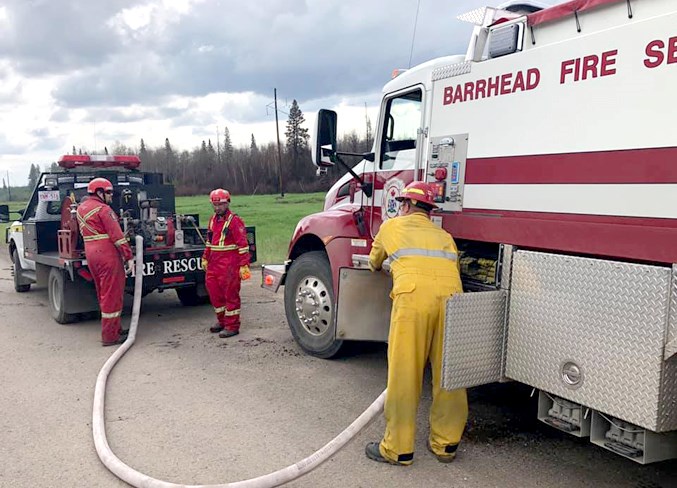Without question, the wildfires in northern Alberta this summer is something everyone would have liked to avoid.
However, it will ultimately benefit firefighters and other emergency services personnel from across the province in the future, not only in terms of what front line workers learned in battling the fires, but also the additional resources that will be available to emergency services workers in the future.
That is what Barrhead Regional Fire Services (BRFS) deputy fire chief Ted Amos said after he and Capt. Leo Knol returned from a week-long stint in the province’s efforts to control the Chuckegg Creek Fire near High Level.
The fire officially named HWF042 started on May 12, and at the height of its destruction necessitated the evacuation of more than 10,000 people including the residents of High Level.
As of July 25, the fire size was reported as encompassing 350,134 hectares and is listed as being held.
“The Alberta Fire Chief’s Association has made close to $600,000 [$580,000] in funding available to create special wildfire attack teams,” said Amos.
Officially known as Wildland Urban Interface protection teams, they will receive additional specialized training in fighting wildfires in populated areas and will lead the attack against wildfires. There will be four of these teams across the province.
“One of their tasks [in addition to being on-call for fire calls] will be to assist other municipal fire departments and provide urban interface fire and structural protection training,” Amos said, noting the province also made additional monies available for the purchase of sprinkler trailers (units which have hoses, pipes and sprinklers used to dampen areas/buildings to prevent embers from nearby fire(s) from igniting others).
“Having this additional training will make us prepared to handle fires in our area, but also when we are called upon to help other jurisdictions, as was the case in High Level.”
Lending a hand
Within three hours of receiving the call from Alberta’s Provincial Operations Centre (POC) on June 23, Amos and Knol hit the road in Engine 5 to do their part in helping reign in the Chuckegg Creek Fire.
After a seven-hour drive, the pair checked in at the emergency operations centre (EOC), they retired to their assigned rooms at a nearby hotel. The next morning they returned to the EOC in the High Level fire department headquarters and had a quick breakfast before joining the morning fire briefing.
“At the morning briefings, we talked about fire behaviour, weather, safety and then were assigned their task for the day,” Amos said.
Depending on the day, tasks ranged from looking for and extinguishing hotspots, supplying water to smaller bush trucks, and doing maintenance checks of water pumps, hoses and sprinklers systems fire preventions systems.
Amos noted that the first two days (June 24 and 25) were fairly easy to handle, but by June 26 temperatures started to increase and that made their tasks more pressing.
“When you are talking about fire behaviour, it doesn’t take much — a change in the wind, the temperature — to increase its direction, intensity and severity,” he said, noting they were especially careful when looking for hotspots.
“A missed hotspot can mean a flare-up or possibly a new fire due to blowing embers.”
Amos added that while looking for hotspots is important, it isn’t necessarily the most exciting job, as it often in means driving along at under 10 kilometres an hour.
Most days, Amos and Knol would return to the EOC for supper anywhere between 7:30 and 9 p.m., but that didn’t mean their day was done. Visiting fire crews were always on call, whether the fire flared up or, just as likely, a residential fire suddenly started.
“We were there not only to fight the forest fire but to supplement the High Level fire department. By the time we arrived, they had already been fighting the fire for more than six weeks. They are tired, their equipment is tired and they needed a break,” he said, adding that fire officials were also concerned that the fire could jump the Peace River and threaten La Crete.
Amos added life in High Level seemed to have returned to normal; in most areas, one could not tell that hundreds of firefighters were battling a major wildfire just outside of the municipality.
“When you were driving through areas like Paddle River, driving into High Level from the south, an hour out, where you can see the burned trees, the scorched earth and the homes that were lost to the fire,” he said.



